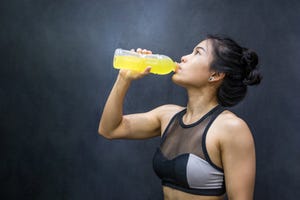Relative to body composition and performance, each sports diet has pros and cons, as well as several dietary ingredients that can help.

One diet doesn’t fit all athletes and active consumers. Each body, each sport or type of exercise has unique nutritional requirements. Each athlete has different goals, different body compositions and different reactions to dieting. A long-distance runner will have different needs than a weightlifter or a sprinter.
Dieting in sports runs the gamut of macronutrient ratios and food and beverage exclusions. A few popular diets include paleo, keto, vegan/vegetarian, gluten-free and intermittent fasting. Relative to body composition and performance, each diet has pros and cons, as well as several dietary ingredients that can help consumers with each diet.
Each macronutrient has a general caloric value: 4 calories per gram for each protein and carbs, and 9 calories per gram for fats. The Institute of Medicine (IOM) set the Acceptable Macronutrient Distribution Range (AMDR) at 10 to 35 percent protein, 45 to 65 percent carbohydrate and 20 to 35 percent fat.
Carb-Restriction
So-called “low-carb” diets tend to restrict carbohydrate intake to below 40 to 45 percent of energy intake. People on these diets forgo sugary foods, breads and pasta in favor of carbs from vegetables and some fruits and unrefined grains.
A very low-carb diet restricts carb intake to 10 percent or less, which eventually puts the body into a state of ketosis, when the body has insufficient glucose levels. Ketone bodies—acetoacetate, acetone and beta hydroxybutyrate (BHB)—from the liver are used to fuel tissue such as the brain, sparing glucose metabolism. The body then uses fatty acids to make adenosine triphosphate (ATP), the energy molecule produced in cell mitochondria.
Low-carb and keto diets tend to be better for endurance sports, which rely more on fat fuel, and not so good for high-intensity exercise, which is mostly carb-driven.
Low-carb diets may leave out foods high in fiber, such as certain grains and fruits, so a fiber supplement may be useful to keep a healthy gastrointestinal (GI) tract and function. These carb foods also contain flavonoids and other phytochemicals, as well as key vitamins and minerals that may provide antioxidant and other functional benefits, so a multivitamin is not a bad idea for low-carb dieters. Eating a wide variety of greens and vegetables could also help fill this void.
During ketosis, insulin levels are lower, and the body secretes more sodium and water. This also taxes potassium supplies, which the body leans on in the absence of sodium. Supplemental sodium or an electrolyte drink could address these issues.
The body’s primary source of energy is glucose from carb intake. Glycolysis, the process of making ATP from glucose, fuels the early stages of anaerobic and aerobic exercise. In a low- or very low-carb diet, glycolysis doesn’t last long. Creatine may help fuel early exercise until fat oxidative ATP production kicks in. Phosphocreatine in the muscles is the first energy source, as the body draws energy from the muscles in the first 10 or so seconds of exercise.
To support the fat-burning phase of keto dieting, carnitine can help shuttle fats into the mitochondria for use in ATP production. Medium-chain triglycerides (MCTs) have also emerged as a good source of fatty acids readily used to both drive energy production and raise ketone levels. One study (Nutr Metab. 2018; 2018: 2630565) found MCT supplementation raised BHB levels and reduced symptoms of keto-induction, including constipation, headache, halitosis, muscle cramps, diarrhea, general weakness and rash. Supplemental BHB has also hit the market as a way to instantly boost ketone levels in the body.
Other ingredients useful for low-carb and keto dieters include beta-alanine, which boosts levels of carnosine to buffer fatigue-triggering histidine that builds up in muscle as a byproduct of ATP production; caffeine, which not only stimulates but also outcompetes fatigue-signaling adenosine in the brain; and, branched chain amino acids (BCAAs)—leucine, isoleucine and valine—not only to compensate for typically moderate protein intake associated with keto dieting, but also to potentially promote fat oxidation.
In its 2017 position stand on diets, the International Society of Sports Nutrition (ISSN) argued the benefit or advantage of keto over non-keto diets may not be due to metabolism changes, but in appetite regulation (JISSN. 201714:16).
“Under non-calorically restricted conditions, [the keto diet] has consistently resulted in body fat and/or body weight reduction,” they wrote. “This occurs via spontaneous energy intake reduction, which could be due to increased satiety through a suppression of ghrelin production … However, it remains unclear whether the appetite suppression is due to ketosis or other factors such as an increased protein or fat intake or restriction of carbohydrate.”
High-Protein
Some diets including low-carb (e.g., Atkins) and paleo, feature higher intakes of protein foods like eggs and meats. Protein is the most satiating macronutrient and drives the building of lean body mass (LBM).
In its position stand on diet and body composition, ISSN noted when protein intakes are comparable, there don’t tend to be significant fat loss differences between keto diets and non-keto diets. They further reported when high protein diets go as high as 4.4. kg/g there is no additional significant change in body composition compared to a regular high protein diet (about 1.8 g/kg).
High protein diets, intakes of 1.6 grams per kilogram and higher, are common in sports nutrition. Protein supplements, functional foods and beverage and snacks and other convenient forms are incredibly popular. High-protein diets feature meat and dairy, including eggs. From milk, whey protein is fast acting and the overall most popular choice before and after exercise, whereas casein is a slower acting dairy protein that is ideal for overnight supplementation. Chicken is hugely popular with athletes, and a protein isolate powder, CHiKPRO from International Dehydrated Foods (IDF), offers athletes an opportunity to get this favored protein in novel forms including soup, pasta and snacks.
For high-protein dieters, several supplements can boost the effectiveness of ingested protein. An amylopectin-chromium combination (as Velositol®, from Nutrition 21) increases insulin and protein synthesis. A combination of the amino acids alanine and glutamine (as Sustamine®, from Kyowa Hakko) is also touted for its ability to help protein increase muscle protein synthesis (MPS), the process of making new muscle, and inhibit muscle protein breakdown (MPB). BCAAs are increasingly popular as a protein complement to boost leucine levels, as leucine has been highlighted as a limiting factor or trigger for MPS. Leucine and its metabolite HMB (beta-hydroxy-beta-methylbutyrate) spark MPS via the mammalian target of rapamycin (mTOR) pathway, which is also activated by another dietary ingredient: phosphatidic acid.
One of the challenges for some high-protein dieters is reduced intake of carbs like breads and pasta; carbs are a preferred energy source for high-intensity training featuring short bursts of exertion and having enough muscle glycogen can be a challenge if certain carbs are restricted. It is important for high-protein eaters to time their carbs for maximum energy going into a workout as well as replenishment after a workout, especially if the next exercise is the next day.
However, endurance athletes like long distance runners and cyclists might fare well on a high-protein diet, as they can more easily reach the point during exercise whereby the body turns to burning fat for energy. Still, the ability to sprint or go hard at various points during an endurance workout might suffer from lack of glycogen stores.
Plant-Based Dieting
High-protein diets increasingly feature plant proteins. Hemp, pea, rice, soy and other plant protein sources are the primary supplemental choice for vegetarian and vegan diets. Nuts, seeds and meat/dairy alternatives line the fridge for these dieters and are also more commonly found in protein products, from bars to powders.
One of the most common questions vegans face is: where do you get your protein? Fortunately, vegan athletes and active consumers need not rely on soy, tofu, nuts and seeds alone. While most plant proteins are not “complete” due to insufficient or lack of certain essential amino acids, blending multiple plant proteins has brought more complete proteins to market. For instance, pea protein has a good leucine content, but is deficient in methionine and cysteine; it is often blended with rice and other plants. Water lentils or duckweed (as Lentein®, from Parabel) is a newer plant protein touted as complete, although some products still blend it with pea protein for better consistency and texture.
Aside from protein, vegans are prone to vitamin B and iron deficiencies, so supplementation with those vitamins, possibly via multivitamin, is crucial.
Low-Fat/High-Carb
At 9 calories per gram, fat is the most energy dense macronutrient. Reducing intake of fat cuts out more calories. Most low-fat diets are also higher in carbs, which is a classic diet for certain endurance athletes including cyclists and runners (before keto picked up steam in recent years). Because the high-carb low-fat (HCLF) leaves less room for protein, this doesn’t tend to be a diet adopted by those looking to gain significant LBM, including bodybuilders and football players.
The days of fats being universally vilified are over, despite the benefits of cutting fat intake on heart health. Dietary fat plays an important role in the body, including certain micronutrient absorption, energy production and inflammation management.
For low-fat and very low-fat dieters, concentrating the small allowance for fat intake on key mono- and poly-unsaturated fats, including omega-3s, may prove beneficial. Supplements or functional foods may be helpful.
Clean Eating
The average modern diet features many processed and “fast” foods. Many sports dieters have eschewed refined and processed foods under the belief a cleaner diet is truer to the human body. The Whole30 and paleo diets are examples. Paleo proponents adopt an ancient hunter-gatherer approach, eating only foods that were available in caveman era (Paleolithic). This means yes to lean meats, vegetables and fruits, but no to dairy, juice, sugar, most grains and legumes.
Many popular sports products like bars, beverages, foods and supplements are processed, so where does that leave paleo devotees? Clean label products, with their short list of recognizable ingredients, can help, but not all will be allowable for the strictest paleo dieters. And while unrefined carbs are OK under this diet, many athletes and active consumers need sufficient carb intake for energy, especially for high-intensity exercise.
Whey and casein are out for paleo athletes, as are milk protein concentrate and other dairy versions. Food is the true protein source here, with nuts, seeds, eggs and plants being OK, but some devotees may only allow the cleanest of plant protein powders.
Without dairy, calcium might be hard to come by, as many such dieters might not eat enough dark leafy greens to get enough calcium. In addition to calcium and vitamin D supplements, paleo followers may look at probiotic supplements. Omega-3s are also warranted if paleo dieters do not eat enough fish.
Who Needs to Eat?
The intermittent fasting approach to sports dieting can take many forms, with fasting occurring on alternate days or certain hours during the day. Whatever the design, intermittent fasting involves a specified period of zero energy intake. In its position statement, ISSN noted research has not yet convincingly answered the question of whether intermittent fasting has a significantly greater impact on body composition than daily calorie restriction.
“Questions remain about whether [intermittent fasting] could outperform daily linear or evenly distributed intakes for the goal of maximizing muscle strength and hypertrophy,” they concluded. ‘[Intermittent fasting] warrants caution and careful planning in programs that require optimal athletic performance.”
For those trying some form of intermittent fasting, BCAAs and creatine do not have a caloric value and could help with MPS, energy and performance. Many also turn more to stimulants, including caffeine, to get a kick before a workout and stave off feelings of fatigue during workout. A multivitamin and mineral supplement would also help provide necessary micronutrients during periods of fasting, evening out micronutrition rather than having drastic hills and valleys.
Unsung Heroes: Enzymes
Whenever someone makes a significant change in the diet, the body can struggle to keep up, at least initially. In the case of ketogenic diets, when an athlete first starts to enter ketosis, energy and performance might drop off as the body tries to find energy. Many keto proponents have reported the body eventually gets used to using fat as a primary fuel and struggles less and less from carb and glycogen decreases; such athletes often called themselves “fat adapted.”
Drastic dietary changes also quickly challenge digestion. Adaptive enzyme secretion means the body makes only those enzymes it needs to digest the foods being eaten, rather than making all possible enzymes all the time. Dietary enzymes are non-caloric molecules that help catalyze nutrient breakdown. Proteases target proteins, lipases tackle fats, amylases handle carbs and cellulases take care of plant fibers. Depending on the specific diet undertaken, different combinations of these digestive enzymes could improve the digestive burden. For example, a keto diet may need less amylases and more lipases and proteases. A vegan diet could benefit from increased cellulases. The high protein diet, of course, would require higher amounts of proteases.
Pure Essence Labs launched a line of digestive enzyme supplements for dieters, called Real-Zymes™, with nine different supplements, each targeting specific diets. For instance, the Atkins version was developed for high-protein diets; the Paleo supplement is for paleo, South Beach and similar plans; and Omnivore is for Weight Watchers, NutriSystem, ADA, Dash and the like. There are digestive blends for vegan, vegetarian, Mediterranean, Ornish and Zone diets.
Burning, Blocking and Satiating
Dieters may find benefits in compounds that help manage the metabolism of and inhibit absorption of various macronutrients, such as carbs and fats. Also, some diets may be light on satiating foods, especially low-energy dieting and fasting.
While many athletes look for increased energy and muscle mass, decreased fat is a top target of dieting. This has made fat-burning supplements popular additions to many athletes’ dietary regimens. Conjugated linoleic acid (CLA), an essential fatty acid (EFA), as well as the thermogenics green tea and 7-keto DHEA are some popular fat-burning supplements touted for increasing metabolism.
Another approach to decreasing fat is addressing fat storage. Garcinia cambogia and its constituent (-)-hydroxycitric acid (HCA) are proposed to inhibit fat biosynthesis.
Low-fat and low-energy diets can lower body levels of leptin, a hormone made in fat cells that works with the brain to manage energy storage. Reduced leptin may trigger the brain to store more fat. An extract of the Japanese plant ashitaba (as ChalCurb™, from Japan Bio Science Laboratory, distributed by ET Horn) may help increase blood levels of leptin and adiponectin, another fat tissue hormone that helps regulate glucose and fat metabolism, including in the muscle (JJCAM. 201 March; 9(1):49-55)—adiponectin decreases in obesity and rises in weight loss.
Certain compounds are marketed for blocking absorption of carbs. A white kidney bean (Phaseolus vulgaris) extract ingredient (as Phase2 carb Controller®, from Pharmachem) was shown to inhibit alpha-amylase enzymes from breaking down starch (carbs) for absorption in the small intestines; this inhibition increased weight loss (Alt Med Rev. 2004; 9(1):63-69).
Ceylon cinnamon (Cinnamomum zeylanicum) has a similar effect on alpha-amylase and reduces the glycemic response to starch ingestion (BMC Complement Altern Med. 2014 Sep 23;14:351).
Feeling full may help curtail caloric intake. Hunger hormones and peptides, including ghrelin and cholecystokinin (CCK), are involved in hunger-satiety signaling. Ingredients impacting satiety through such signaling include glycomacropeptide, a protein extract (as Slendesta®, from Kemin health) and dietary fibers such as galacto-oligosaccaride (GOS), fructo-oligosaccharide (FOS) and beta-glucans from oats and barley.
Future of Sports Dieting
As long as athletes and active consumers strive to lose fat and increase muscle while maintaining adequate energy levels for exercise, there will be plenty of diet plans on offer. Specific dieting and exercise goals should determine the appropriate diet. There is no one-size-fits-all diet for athletes, and most diets can be effective under the right circumstances.
“A wide range of dietary approaches (low-fat to low-carbohydrate/ketogenic, and all points between) can be similarly effective for improving body composition, and this allows flexibility with program design,” ISSN concluded, in its position stand on body composition and diets. “The long-term success of a diet depends upon compliance and suppression or circumvention of mitigating factors such as adaptive thermogenesis.”
Whichever diet an athlete or active consumer chooses, supplements can help them achieve their diet, body composition and, ultimately, performance goals.
About the Author(s)
You May Also Like






.png?width=800&auto=webp&quality=80&disable=upscale)